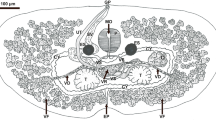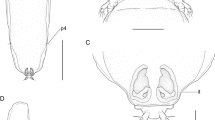Abstract
A new species of Heligmonellidae (Trichostrongylina, Heligmosomoidea), Stilestrongylus kaaguyporai n. sp. is described from the small intestine of Euryoryzomys russatus (Rodentia, Cricetidae, Sigmodontinae) from the Argentine Atlantic Forest, in the Misiones province. The new species was found at Campo Anexo Manuel Belgrano, Reserva de Vida Silvestre Urugua-í and Parque Provincial Urugua-í, with a prevalence of 73% in 15 hosts examined. Stilestrongylus includes 24 Neotropical species, all parasitic in rodents, mostly Sigmodontinae. Stilestrongylus kaaguyporai n. sp. can be differentiated from its congeners by the following characters: caudal bursa dissymmetrical with right lobe larger and pattern of type1–4 in both lobes, rays 6 not forming a lateral trident with rays 4 and 5, rays 8 with dissymmetrical pathway, genital cone hypertrophied with a conspicuous hood-like projection and females with a marked dorso-ventral torsion of the posterior end. This report is the second record of a Stilestrongylus species in E. russatus, increasing to nine the number of parasitic species known from this host.


Similar content being viewed by others
References
Costa MAR, Maldonado A Jr, Bóia MN, Lucio CS, Simões RO (2014) A new species of Hassalstrongylus (Nematoda: Heligmonelidae) from Euryoryzomys russatus (Rodentia: Sigmodontinae) in the Atlantic Forest, Brazil. Neotrop Helminthol 8:235–242
Durette-Desset MC (1985) Trichostrongyloid nematodes and their vertebrate hosts: reconstruction of the phylogeny of a parasitic group. Adv Parasitol 24:239–306
Durette-Desset MC, Chabaud AG (1993) Nomenclature des Strongylida au-dessus du groupe famille. Ann Parasitol Hum Comp 68:111–112
Durette-Desset MC, Digiani MC (2005) The axis of orientation of the synlophe in the Heligmosomoidea (Nematoda, Trichostrongylina): a new approach. Parasite 12:195–202
Durette-Desset MC, Digiani MC (2012) The caudal bursa in the Heligmonellidae (Nematoda: Trichostrongylina). Characterization and hypothesis on its evolution. Parasite 19:3–18
Durette-Desset MC, Digiani MC, Kilani M, Geffard-Kuriyama D (2017) Critical revision of the Heligmonellidae (Nematoda: Trichostrongylina: Heligmosomoidea). Mémoires du Muséum national d’Histoire naturelle 211, Paris
Gomes DC, Pereira R, Vicente JJ, Pinto RM (2003) Nematode parasites of marsupials and small rodents from the Brazilian Atlantic Forest in the state of Rio de Janeiro, Brazil. Rev Bras Zool 20:699–707
Jones C, Mc Shea W, Conroy M, Kunz T (1996) Capturing mammals. In: Wilson DE, Cole FR, Nichols JD, Rudran R, Foster MS (eds) Measuring and monitoring biological diversity—standard methods for mammals. Smithsonian Institution Press, Washington & London, pp 115–155
Panisse G, Robles MR, Digiani MC, Notarnicola J, Galliari C, Navone GT (2017) Description of the helminth communities of sympatric rodents (Muroidea: Cricetidae) from the Atlantic Forest in northeastern Argentina. Zootaxa 4337(2):243–262
Percequillo AR (2015) Genus Euryoryzomys Weksler, Percequillo and Voss, 2006 En: Patton JL, Pardiñas UFJ and D’Elía G (eds) mammals of South America, volume 2 rodents. The University of Chicago Press, Chicago & London, pp 312–322
Pinto RM, Kohn A, Fernandes BMM, Mello DA (1982) Nematodes of rodents in Brazil with description of Aspidodera vicentei n. sp. Syst Parasitol 4:263–267
Simões RO, Souza JGR, Maldonado Jr A, Luque JL (2011) Variation in the helminth community structure of three sympatric sigmodontine rodents from the coastal Atlantic Forest of Rio de Janeiro, Brazil. J Helminthol 85:171–178
Travassos L (1937) Revisão da familia Trichostrongylidae Leiper, 1912. Monographias do Instituto Oswaldo Cruz:1–512
Acknowledgements
We thank Carlos Galliari, Ulyses Pardiñas, María del R. Robles, Marcela Lareschi, Juliana Sánchez, Natalia Guerreiro Martins, Cecilia Ezquiaga, Jorge Barneche and Julio Torres for their cooperation in the host collections; Carlos Galliari and Ulyses Pardiñas for the identification of the hosts; María Laura Morote for her assistance with the drawings; Graciela T. Navone and María del R. Robles for useful comments on the ms and the Misiones people for allowing us to work in their forest, through the Ministerio de Ecología y Recursos Naturales Renovables de la Provincia de Misiones.
Funding
Field and laboratory activities were economically supported by grants from Agencia Nacional de Promoción Científica y Tecnológica (PICT 2010-0924) and Universidad Nacional de La Plata (N627 and N753 from Programa de Incentivos). We are deeply indebted to the above mentioned persons and institutions.
Author information
Authors and Affiliations
Corresponding author
Ethics declarations
The research has been conducted according to Argentine laws. Sample collection was carried out during fieldwork under official permits granted by the Ministerio de Ecología, RNR y Turismo, Provincia de Misiones (autorización #23, Guía Tránsito 000685 and 000699). The study was carried out in accordance with the recommendations in the Guide for the Care and Use of Laboratory Animals of the National Institutes of Health. The specimens obtained with methods for live capture were studied and humanely sacrificed following the procedures and protocols approved by national laws (LN 14.346 and references in the provincial permits) and by the Comité de Ética of the Consejo Nacional de Investigaciones Científicas y Técnicas (CONICET) (Resolución 1047, sección 2, anexo II).
Rights and permissions
About this article
Cite this article
Panisse, G., Digiani, M.C. A new species of Stilestrongylus (Nematoda, Heligmonellidae) from the Atlantic Forest of Misiones, Argentina, parasitic in Euryoryzomys russatus (Cricetidae, Sigmodontinae). Parasitol Res 117, 1205–1210 (2018). https://doi.org/10.1007/s00436-018-5801-2
Received:
Accepted:
Published:
Issue Date:
DOI: https://doi.org/10.1007/s00436-018-5801-2




